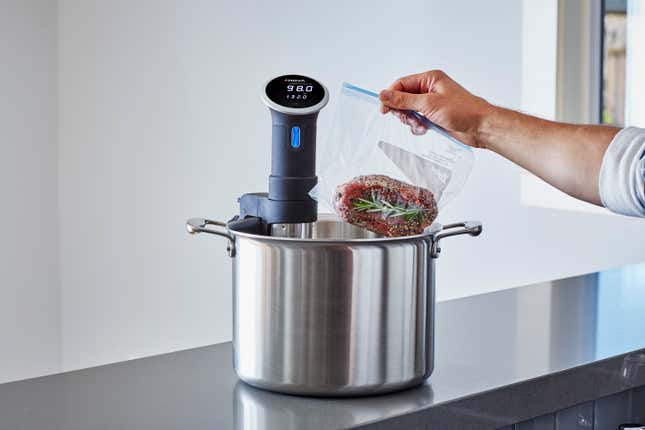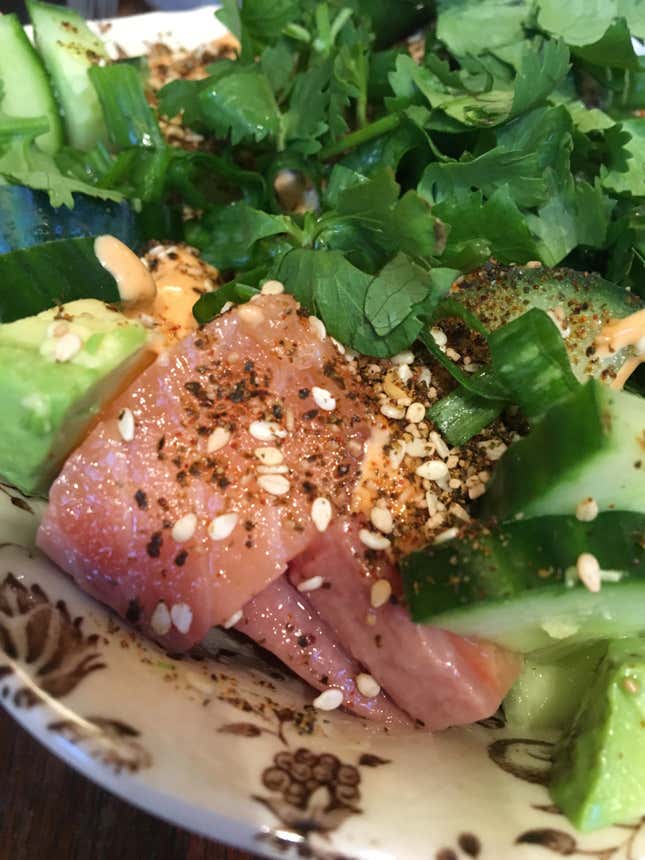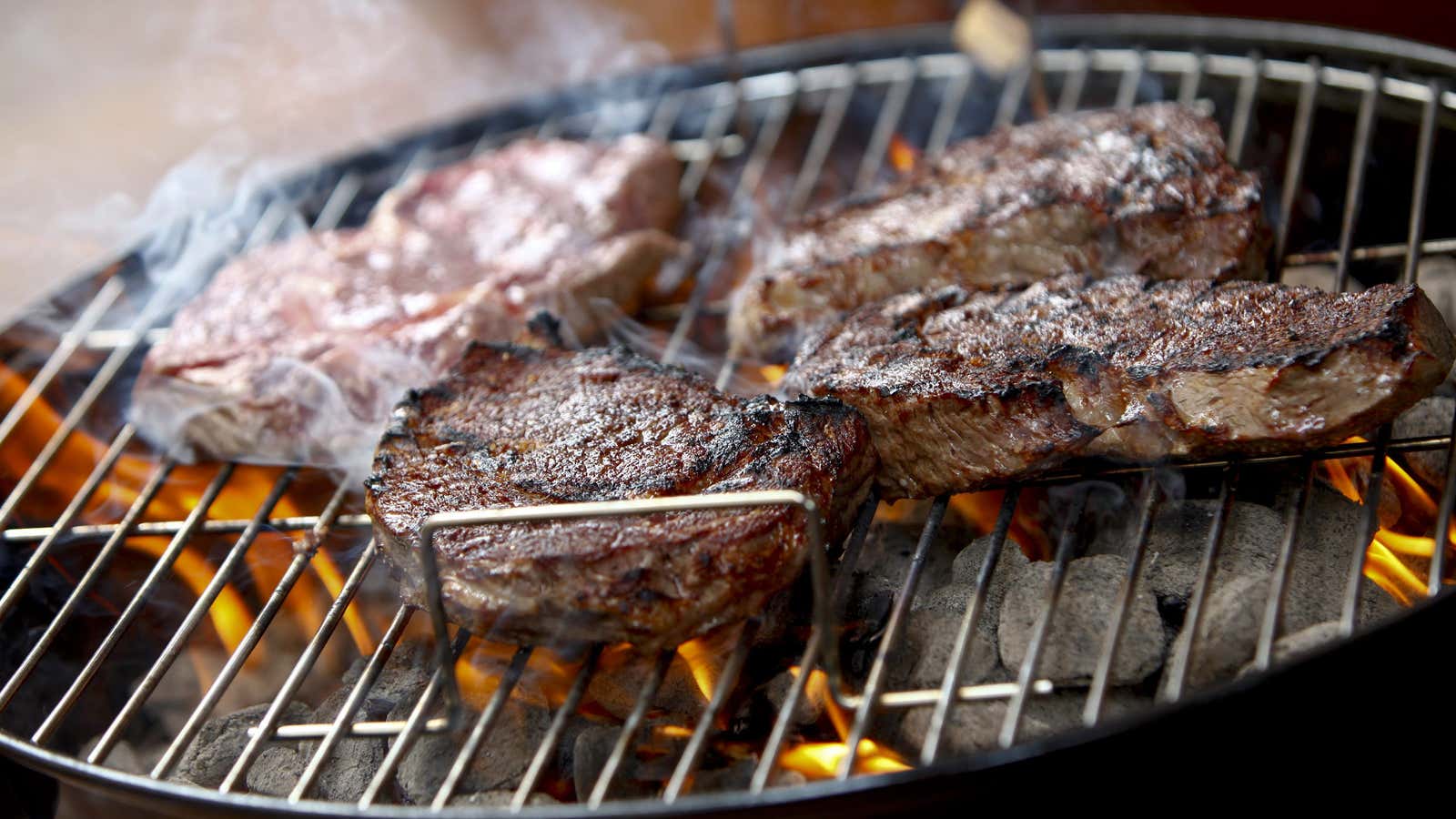Sous vide, the cooking technique that high-end chefs use to deliver juicy rare steak and perfectly cooked fish at restaurants, has come home.
The method, which means “under vacuum” in French but has come to refer to a broader approach to low-temperature cooking, is already ubiquitous in luxury dining. Food is sealed in plastic, sometimes pressurized and infused with flavorings, then slowly heated in temperature-calibrated water baths called immersion circulators.
The beauty of sous vide is its precision. It allows the cook total control over the temperature of the food, without the variation or guesswork of high-heat cooking. So a steak can be perfectly pink from top to bottom, ready for a quick sear to burnish and caramelize its surfaces. A lean chicken breast can be brought slowly to exactly 140°F (60°C) so it stays buttery and juicy, instead of overcooked, stringy and dry.
Chefs have come to rely heavily upon sous vide. “It would be fair to say that if you go to a high-end restaurant in New York, or definitely in Europe, you’re going to have a bite of something sous vide,” the New York chef Dan Barber has said. “When you’re a chef and you’re in pursuit of intensity of flavor, there really isn’t a better technology.”
But until recently, home sous vide was just for hard-core enthusiasts–those willing to drop several hundred dollars for bulky immersion circulator machines, or rig a system up MacGyver-style with beer coolers and instant-read thermometers. Fears of bacterial contamination when the method is used improperly have deterred some from trying it.
In the last few years, however, a new generation of relatively affordable immersion circulators have hit the market. Priced at around $200 and up, these wands clip onto the side of any stockpot. They heat water to within a fraction of a chosen degree—without a counter-hogging standing tub contraption. Companies that make these precision cookers include Anova, Nomiku, and Sansaire. A basic vacuum sealer is also useful but not necessary; sturdy zip-lock bags work too.

With these new gadgets, and a slew of smart new cookbooks offering sous vide recipes, the method has become accessible even to those without supreme kitchen confidence. It’s hard to go wrong with the precision of programmable temperatures and times, which make overcooking pretty much impossible. (That’s why chefs have long relied upon the method to standardize signature dishes served night after night, across restaurant empires spanning cities.) As for undercooking, it turns out that killing harmful bacteria in food is a function not just of temperature but also of time—so properly done sous vide, even at lower temperatures, is as reliable a method as traditional cooking.
This may be the summer when sous vide really establishes itself as more than a fad in home cooking. It certainly has in my kitchen. I bought an Anova a few months ago, and as a working mother have found it indispensable for weeknight cooking.
This summer, especially when the weather is too hot to consider turning on the stove, I plan to put it through its paces. For salad lunches, cold suppers, or picnics, a home sous vide cooker turns out revelatory hard-boiled eggs and delicately poached fish or chicken, as well as carrots with a sweet, earthy flavor that retain a toothsome bite. At a lower temperature, it transforms fish fillets into a silky, sashimi-like mass, perfect for the Hawaiian poké salads that are a recent obsession of mine (and apparently all of Manhattan).
But the highest purpose of a sous vide machine is, undoubtedly, red meat. And for grilling, a sous vide bath in advance of firing up the coals is a genius trick to ensure meat is properly cooked, and avoid the heartbreak of ruining a pricey steak.
J. Kenji López-Alt has written extensively on sous vide, and his guide at Serious Eats is a great primer. (His excellent cookbook, The Food Lab, also includes a section on sous vide.) And Dave Arnold’s visual charts (pdf) for the site Cooking Issues are also handy.
But for sous vide newbies, here are some reasons to try the technique out this summer:
You’ll become a grilling ninja
The biggest reason to cook your steak sous vide is to avoid the gray band. That’s the layer of meat, when you cut into a slice, between the browned edges and the pink (or red) center. No matter how skilled you are with the grill or skillet, a well-charred traditionally cooked steak will inevitably have that double-layer of overcooked meat.
With sous vide cooking, however, you can bring the entire piece of meat to your preferred temperature—120°F (49°C) for rare, 135°F (57°C) for medium, 156°F (69°C) for well-done—and then slap it on a hot grill (or cast-iron pan) for a quick char on each side. The meat will be browned on the outside, and cooked to your liking top to bottom.
Even cheaper cuts of steak—which are often more flavorful than filet mignon, but can be tough when cooked on the grill—become tender after a long enough sous vide bath at the right temperature. The method melts the fat in marbled meat and converts the connective tissue collagen to tender gelatin, but stops short of the overcooking that toughens and dries the muscle.
The great bonus of cooking sous vide is that it’s a way to manage your time and anxiety on a day of summer grilling. You can sous vide your steaks earlier in the day, and then hold them at temperature for several hours before a final quick sear and serve—allowing ample time to prep a side salad, grill some hot dogs for the children, and pour yourself a cocktail.
Again, López-Alt is required reading, this time, his treatise on sous vide steak.
You’ll rediscover the simple pleasure of eggs
Even the least confident cook probably knows how to boil an egg. But eggs from a sous vide cooker are an entirely different matter.
The cooker can produce the kind of slow-poached eggs that chef David Chang popularized at his Momofuku empire—perfectly quivery when cracked over roasted or grilled asparagus, or into a bowl of ramen soup. And it creates fudgy-yolked hard-boiled eggs that will put any crumbly, green-tinged boiled egg to shame. Sous vide eggs will hold for several days in the fridge, so I usually do a dozen at a time, then eat them throughout the week—pickled in soy sauce, cracked over warm greens and rice, tossed with pasta and parmesan, or simply on toast.
This is dead-easy sous vide. The shell encases the egg, so it doesn’t even require vacuum-sealing. And it’s a great place to experiment with the beer-cooler method if you’re not ready to invest in an immersion circulator. López-Alt’s handy guide to cooking times and temperatures is here.
You’ll stop paying premium prices for dodgy raw fish

The high-quality, flash-frozen “sashimi-grade” fish that good restaurants and sushi bars serve is expensive stuff that’s hard to find for the home cook. It often comes from fishing operations that are far from sustainable, and it’s not always safe to eat.
Sous vide, however, offers a nifty trick for raw fish preparations that’s safe for the home cook. After a brine and sous vide bath, fish can still retain the translucence of sashimi, with a silky texture. Then you can cool it and serve it as sushi, crudo, tartar, or poké. Here’s my favorite recipe for the Hawaiian raw fish salad.
